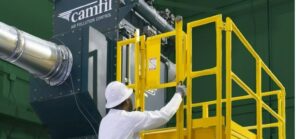Industrial dust collection systems are used in many facilities to remove the fine dust particles that escape into the air during manufacturing operations.Dust collectors typically contain multiple filters that capture the dust and other airborne particles as the airflow circulates through. Periodic pulse cleaning maintains the efficiency of the filters for the highest indoor air quality.
Unlike HVAC systems that use filters that are disposed of as soon as they fill with dust, dust collectors use filter cartridges that can be cleaned each time they load with dust. This “self-cleaning” enables cartridges to be replaced much less frequently, even in areas with heavy dust loads. This continual filter cleaning reduces filter costs as well as the downtime associated with changing out filters.
These filter cleaning systems are called pulse cleaning systems because they use quick pulses of compressed air to blow the dust from the cartridges. The pulse cleaning ensures that filters do not become quickly clogged with dust and continue to work at rated efficiencies when first installed in the dust collection system.
Without pulse cleaning, filters can require replacement every few minutes in some environments. A dirty filter media can also affect a dust collector’s effectiveness and life.
Removing Dust from Filter Cartridges
As dust-laden air goes through the dust collector, it must pass through the filter cartridges which are filled with fabric called filter media. The dust particles get trapped on the surface of the media, so only clean air exits the cartridges and then the dust collector.
This trapped dust forms a dust cake on the surface of the filter media, making it harder and harder for the air to pass through. This airflow resistance, known as pressure drop, increases as the dust layer increases. The decreasing air flow rate makes the dust collector motor work harder, consuming more energy to continue drawing air through. When air resistance (pressure drop) reaches a certain point, pulse cleaning activates to remove the dust cake.
This process continues until the dust load increases to a point where pulse cleaning no longer makes a difference, requiring filter replacement. However, this may happen many months down the road if filters are effectively pulse cleaned.
Pulse Cleaning Process
A pulse cleaning system uses compressed air to remove the dust cake from the filter cartridge. Short quirk bursts of high-velocity air are shot into the center of the filter to remove the dust cake. The air blast must be strong enough to loosen and remove the caked-on dust without causing damage to the filter media or cartridge.
To efficiently clean the filters, the dry air is compressed between 90 and 100 psi. Higher pressures can damage the filter media while lower levels may not be effective enough for a thorough cleaning. As the air blasts in the reverse direction of the main airflow, the process is often called reverse pulse cleaning.
The loosened dust falls into a hopper at the bottom of the dust collector for safe disposal. Upon removal, the dust collector retains a lower pressure drop, using less energy. The cleaning process also helps filters last longer. Click below to see how pulse cleaning works.
On Demand or Continuous Operations
Operators of dust collection systems can program the pulse cleaning system to operate continuously or on-demand. When working continuously, the system turns off and on at preset intervals. This mode is ideal when filtering porous dust such as silica, lightweight dust such as fumed silica, or high-load applications including thermal spray or plasma cutting.
On-demand cleaning is activated when the pressure drop reaches a programmed high setpoint and turns off when reaching a programmed low setpoint. In this mode, the dust collector operates in a very narrow pressure drop range and uses less compressed air that optimizes filter cleaning efficiency.
Overcleaning filters can reduce filter life and result in higher energy costs due to the overuse of compressed air. As such, operations should be chosen to suit dust type and filter design. Your dust collection supplier can help determine which is best.
Filter Types
High-efficiency filter cartridges are used in dust collection systems as they can capture 99.97% of airborne particles including dust in the 0.3-micron range. They also can handle higher airflows and clean more thoroughly with each pulse of compressed air. Lower-cost replacement filters cannot handle the power of pulse cleaning and may malfunction, releasing dust into the environment.
Depending on dust type, operating temperature, and moisture levels of a process, a filter cartridge may be chosen with either nonwoven cellulosic blend or synthetic polyester media type. This media is the fabric pleated inside the filter. The fibers of the filter fabric capture the dust particles.
Nonwoven cellulosic blends are the most economical for dry dust collection with operation temperatures up to 160°F (71°C) while synthetic polyester is a more lightweight media that can handle dry applications with temperature ranges from 180°F (82°C) up to 265°F (129°C).
Hemi-Pleat Technology
The pleating of the media within the cartridge can make a difference in air resistance and efficiency. Pleats too tightly packed can increase air resistance through the filters while a wide pleat keeps resistance lower through the filter and releases more collected dust.
Camfil’s Gold Cone™ cartridges feature a proprietary HemiPleat® outer pack and a gold cone inner pack that stays cleaner and lasts longer than conventional pleated filters. HemiPleat technology uses synthetic beads to hold pleats open and evenly spaced to expose more media to the airstream. An open-bottomed inner cone of media greatly expands the usable surface of the cartridge. As a result, the filters have more usable media than any other filter on the market.
More dust can load onto the filter and be released during pulse cleaning. The filter also provides a lower pressure drop so fewer units are needed to meet the specifications of an application.
During pulse cleaning, the cone is configured so that compressed air evenly distributes from top to bottom along the outer pack of the filter and down through the inner pack. At each pulse of compressed air, a maximum amount of dust ejects from the collector while maintaining a low-pressure drop.
Unlike horizontal-style filters which pulse most of the dust onto adjacent and lower filters, and a fraction into the hopper, 40% of each HemiPleat cartridge discharges collected dust straight down to the hopper,
Gold Cone filter cartridges are exclusively used in Gold Series and Gold Series X-FLO dust collectors that handle toxic and combustible dust, smoke, and fumes. Each module holds four filter cartridges of HemiPleat filter media. Working together, they exceed OHSA mandates for factory air quality and provide the most powerful and cost-efficient dust collection system in the market today.
Click here for more information about Gold Cone filters. For assistance in controlling dust generated in manufacturing, email .
 Americas
Americas 





